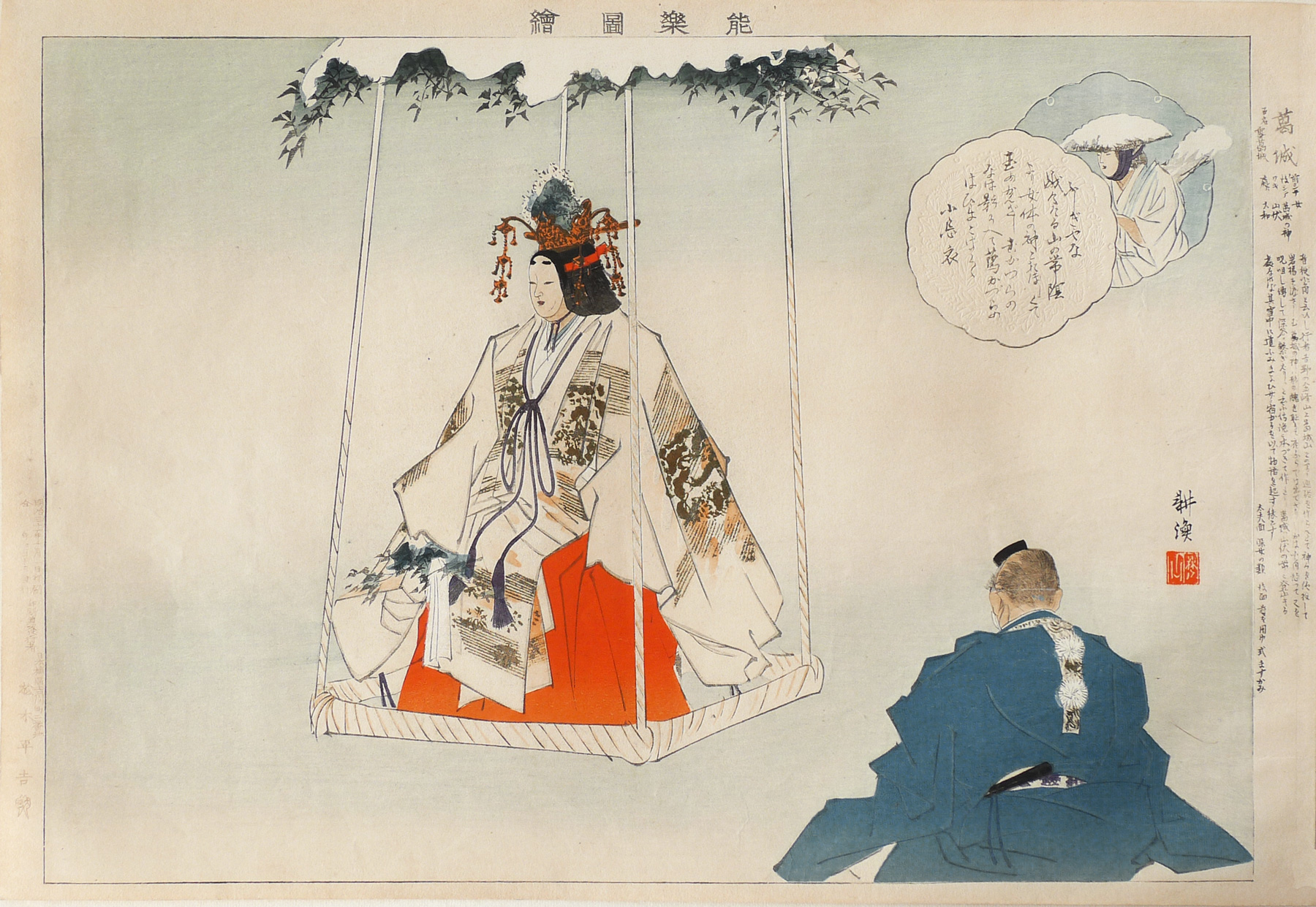About This Print
One of 261 prints from the series Nōgakuzue (Illustrations of Noh). The print depicts a scene from the Noh play Kazuraki, attributed to the playwright Zeami Motokiyo (1363-1443) in which a yamabushi priest (note the characteristic hat) sits before an old woman transformed into a goddess.
For another rendition of this play by the artist see IHL Cat. #283.
For background on the Noh theater see the article on this site "Noh - A Brief Summary by Beata Kubiak Ho-Chi".
The Play - Kazuraki
Sources: Hirotakansyokai website http://hirota-kansyokai.la.coocan.jp/eibun/images/5kaiKazuraki.pdf and A Guide to No, P.G. O'Neill, Hinoki Shoten, 1929, p. 76-77.
Characters
Act 1
Act 2 Waki
Waki-tsure
Shite
Kyōgen
Nochi-shite a yamabushi priest
two attendant priests
a village woman
a local person
the goddess of Mt. Kazuraki
Act 2
Waki-tsure
Shite
Kyōgen
Nochi-shite
two attendant priests
a village woman
a local person
the goddess of Mt. Kazuraki
A traveling monk leaves Mt. Haguro (in Yamagata-Prefecture) on his pilgrimage to Kazuraki-Shrine. Having arrived at Mt. Kazuraki in Yamato (in present-day Nara Prefecture), and after crossing over the peaks of mountains, he is suddenly caught in a heavy snowfall and loses his way. A local woman with a bundle of sticks on her back finds him in trouble, and feels pity for him. She offers him to stay overnight at her humble cottage down in a shadowy valley, and entertains him by building a fire with shimoto - a bundle of sticks collected in deep snow, much famed in Mt. Kazuraki. Not knowing what it is, he asks her about it. She explains, citing an old waka-poem, that the sticks bound together by a creeper reed became so famous as to be commonly associated in their minds with the mountain, and narrates tenderly of poetry and Yamato dances. At last she tells that she, the Kazuraki Goddess, was ordered by En no Gyoja1 to build a rock bridge from Mt. Kazuraki to Mt. Ohmine, but failed in doing so because she did not want to work during the day, hating to expose her ugly looks to the world. Thus she incurred his anger and was bound to eternal agony and suffering. She, therefore, begs him to free her from bondage.
In the stillness of night, as his clothes dry out, the monk starts his religious service. Drawn by the healing power of the religious chanting, the woman appears in the shape of the goddess, and, freed from her bonds, performs before him the Yamato dance in the snow and in the moonlight, so gracefully as if surveying the whole expanse of the Yamato field from a mountain top. As the early light of dawn approaches, however, she hides herself in a rock cave, fearing to expose her looks. (summary by Takao Saijo)
1 En no Gyoja: a semi-legendary sorcerer endowed with supernatural powers, would order spirits and demons to do his bidding, and when they refused, he would bind them to a spell.
Right Margin Description of Scene
Print Details
| IHL Catalog | #998 |
| Title | Kazuraki 葛城 |
| Series | Nōgakuzue 能樂圖繪 (Illustrations of Noh) |
| Artist | Tsukioka Kōgyo (1869-1927) |
| Signature | Kōgyo 耕漁 |
| Seal |  Rekizan, seal no. 68, p. 171 in The Beauty of Silence: Nō and Nature Prints by Tsukioka Kōgyo (1869-1927), Robert Schaap & J. Thomas Rimer, Hotei Publishing, 2010. |
| Date | This collection's print is dated Meiji 31, 1898, as follows: 明治三十一年十月一日印刷 Date of Printing: October 1, 1898 (Meiji 31) 明治三十一年十月十日発行 Date of Issue: October 10, 1898 (Meiji 31) The ARC database entry for their print arcUP0930 carries an earlier date than this collection's print, as follows: 明治三十一年二月十日印刷仝年仝月十五日発行 Date of Printing: February 10, 1898 Date of Issuance: February 15, 1898. |
| Edition | unknown |
| Publisher | Matsuki Heikichi (Daikokuya Heikichi 大黒屋平) [Marks: pub. ref. 029] |
| Carver | |
| Impression | excellent |
| Colors | excellent |
| Condition | excellent - not backed; slight wrinkling |
| Genre | ukiyo-e |
| Miscellaneous | gold metallic highlights robe and embossing on scalolped-edged circular cartouche |
| Format | oban yoko-e |
| H x W Paper | 9 5/8 x 14 1/4 in. (24.4 x 36.2 cm) |
| H x W Image | 8 7/8 x 13 in. (22.5 x 33 cm) area within printed black border |
| Collections This Print | Art Institute of Chicago 1939.2258.87; Art Research Center, Ritsumeikan University AcNo.arcUP0910; University of Pittsburgh 20091209-kogyo-0258; The British Museum 1949,0409,0.34 |
| Reference Literature |


